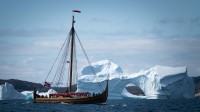 For the first time in a thousand years, a Viking longship has crossed the North Atlantic. The Draken Harald Hårfagre reached port of St. Anthony in Newfoundland on June 1st. It was not an easy voyage. There’s only a short window in late spring and early summer when crossing the frigid waters of the North Atlantic is possible, and even then conditions are challenging, to put it mildly.
For the first time in a thousand years, a Viking longship has crossed the North Atlantic. The Draken Harald Hårfagre reached port of St. Anthony in Newfoundland on June 1st. It was not an easy voyage. There’s only a short window in late spring and early summer when crossing the frigid waters of the North Atlantic is possible, and even then conditions are challenging, to put it mildly.
After setting sail from Haugesund, Norway, on April 23rd, the Draken made its first unplanned stop just three days later on Lerwick in the Shetland Islands. One of the ship’s shrouds (rigging connected to the mast) had parted a day after departure so the crew stopped at Lerwick to make the repairs. They had to take down the mast to do it, which is a harder job now than it would have been for the Vikings because they didn’t have electronic equipment on their masts.
On April 27th the Draken set sail again, making for Tórshavn on the Faroe Islands. They arrived May 2nd and had to stay until May 6th waiting for propitious winds. The crew took advantage of the longer stop to examine the 3,200-square-foot silk sail for damage. You can see highlights of the trip from the Shetlands to the Faroes in this video. It’s damn hard going.
[youtube=https://youtu.be/MaT5q7ryOyU&w=430]
The next leg of the voyage took them to Reykjavik, Iceland. The landed in Reykjavik Harbour on May 9th and were again compelled to wait out the wind, this time for a full week. This amazing video features the Captain of the Draken Björn Ahlander in Iceland, talking about how the difficulties of the voyage only strengthened his crew’s bond and pointing out the commonalities between their experience navigating the longship and the Viking’s. There is footage of them sailing in a storm with waves battering the clinker-built ship. In the beginning he’s holding up a piece of Iceland feldspar, the stone his seafaring Viking ancestors used to find the sun even through thick cloud cover. He’s being filmed in Tingvallir, by the way, the place where Iceland’s Althing, or parliament, first met in 930. Tingvallir remained the site of the Icelandic Parliament until 1798. It is now a national park.
[youtube=https://youtu.be/cL1Xqehe93g&w=430]
The northeasterly wind they were waiting for finally graced them with its presence on the 16th and off the Draken went to Greenland. On May 21st, the reached the harbour of Qaqortoq, southwest Greenland, navigating the same waters Leif Eriksson navigated when he founded the first European settlement on Greenland in around 1000 A.D. The crew made good use of their time there, too. Captain officiated at the wedding of two crew members in the ruins of the early 12th century church in Hvalsey. The last record we have of the Norse settlement in Greenland was a wedding held in that same church between Thorstein Olafsson and Sigrid Björnsdottir on September 14th, 1408.
[youtube=https://youtu.be/EiO9EGt2qdk&w=430]
On May 27th, the Draken set a course for North America. The final leg from Greenland to Newfoundland proved the most difficult. Icebergs, dense fog, harsh and unpredictable winds put the Draken‘s crew of 32 volunteers to the test. Modern water-repellant clothing could not keep them dry, and layers of thick knit sweaters could not keep them warm, but the elements could not break them either. On Wednesday they reached Newfoundland, landing near L’Anse aux Meadows where the remains of a Viking settlement were discovered in 1960.
Soon the valiant Draken and its riders will head inland for Quebec City and its summer tour of the Great Lakes and canals. No more icebergs for the forseeable future.